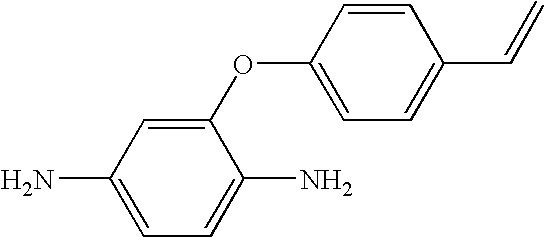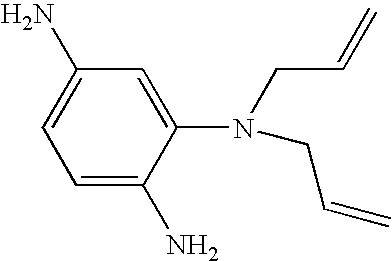Hybrid polymer materials for liquid crystal alignment layers
a hybrid polymer and alignment layer technology, applied in the field of hybrid polymer composition, can solve the problems of reducing the electrical performance and optical stability of the device, affecting the long-term stability and performance of the device, and low assembly line throughput, so as to minimize the risk of damage to other materials, reduce the exposure energy, and reduce the exposure energy
- Summary
- Abstract
- Description
- Claims
- Application Information
AI Technical Summary
Benefits of technology
Problems solved by technology
Method used
Image
Examples
example 2
[0096] The following example describes the synthesis of novel Addition Monomer 2 for use in the preparation of hybrid polymers of the invention.
[0097] 3-(4-Hydroxy-phenyl)-acrylic Acid hexadecyl Ester 30
[0098] 4-Hydroxy cinnamic acid (10 g, 61 mmol) was combined with 1-hexadecanol (14.0 g, 58 mmol), p-toluenesulfonic acid (1.2 g, 6.3 mmol) and 100 ml toluene and heated to 140.degree. C. for 24 h with continual removal of water using a Dean-Stark distillation apparatus. The mixture was cooled to room temperature and 50 ml ethyl acetate added. The solution was washed with water, 5% sodium hydrogen carbonate, brine and then dried over magnesium sulfate. The product was recrystallized from ethyl acetate to give 4.8 g 3-(4-hydroxy-phenyl)-acrylic acid hexadecyl ester.
[0099] 3-[4-(6-Hydroxy-hexyloxy)-phenyl]-acrylic Acid Hexadecyl Ester 31
[0100] 3-(4-Hydroxy-phenyl)-acrylic acid hexadecyl ester (4.8 g, 12.4 mmol) was dissolved in 100 ml of NMP. To this was added 6-chlorohexanol (2.19 g, 1...
example 3
[0103] The following example describes the synthesis of novel Addition Monomer 3 for use in the preparation of hybrid polymers of the invention.
[0104] 4-(6-Hydroxy-hexyloxy)-benzaldehyde 33
[0105] 4-Hydroxybenzaldehyde (15 g, 122 mmol) was dissolved in 150 ml of NMP. 6-Chlorohexanol (20.16 g 146 mmol), anhydrous potassium carbonate (20.36 g, 146 mmol) and a catalytic amount of potassium iodide were added. The batch was stirred at 90 C for 24 hours. Water was added to the cooled solution, which was subsequently extracted with 3.times.100 mls of ethyl acetate. The combined organics were washed with 5% KOH (2.times.100 mls), brine solution and then dried over magnesium sulfate. The concentrated product was then recrystallized from a 1:1 mixture of ethyl acetate / hexane to give 14 g of an off-white solid.
[0106] 3-[4-(6-Hydroxy-hexyloxy)-phenyl]-1-(4-iodo-phenyl)-propenone 34
[0107] 4-Iodoacetophenone (2.46 g, 10 mmol) was dissolved in 20 ml toluene. 4-(6-Hydroxyhexyloxy)benzaldehyde (10 mm...
example 4
[0112] The following example describes the synthesis of novel Addition Monomer 4 for use in the preparation of hybrid polymers of the invention.
[0113] 1-[4-(6-Hydroxy-hexyloxy)-phenyl]-3-phenyl-propenone 37
[0114] 4'-Hydroxychalcone (15 g, 67 mmol) was dissolved in 150 ml of NMP. 6-Chlorohexanol (13.72 g, 100 mmol), anhydrous potassium carbonate (9.24 g, 67 mmol) and a catalytic amount of potassium iodide were added. The batch was stirred at 90.degree. C. for 27 hours. Water was added to the cooled solution, which was subsequently extracted with 3.times.100 mls of ethyl acetate. The combined organics were washed with 5% NaOH (2.times.100 mls), water and brine solution and then dried over magnesium sulfate. The ethyl acetate solution was partially concentrated and then cooled to crystallize out the product, yielding 17.5 g of white solid.
[0115] 2-Methyl-acrylic Acid 6-[4-(3-phenyl-acryloyl)-phenoxy]-hexyl Ester, Addition Monomer 4 38
[0116] To an ice-cooled solution of 1-[4-(6-hydroxy-...
PUM
| Property | Measurement | Unit |
|---|---|---|
| mol % | aaaaa | aaaaa |
| mol % | aaaaa | aaaaa |
| wt % | aaaaa | aaaaa |
Abstract
Description
Claims
Application Information
 Login to View More
Login to View More - R&D
- Intellectual Property
- Life Sciences
- Materials
- Tech Scout
- Unparalleled Data Quality
- Higher Quality Content
- 60% Fewer Hallucinations
Browse by: Latest US Patents, China's latest patents, Technical Efficacy Thesaurus, Application Domain, Technology Topic, Popular Technical Reports.
© 2025 PatSnap. All rights reserved.Legal|Privacy policy|Modern Slavery Act Transparency Statement|Sitemap|About US| Contact US: help@patsnap.com



